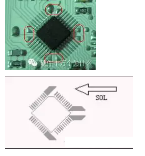1. Test points should be added to the components of the chip that are not connected to plug-in parts. The diameter of the test pads should range between 1.0mm and 1.5mm, making them suitable for testing with an in-circuit tester. The edge of the test pad must be at least 0.4mm away from the surrounding pad. The test pad should have a minimum diameter of 1mm and must have network connectivity. The center-to-center distance between two test pads should be no less than 2.54mm. If a via is used as a test point, a pad must be placed outside the via, with a size of at least 1mm (inclusive).
2. Any hole that has an electrical connection must be padded. All pads must have network properties, and if there's no component on a network, its name must be unique. The distance between the center of the positioning hole and the center of the test pad should be more than 3mm. For irregular shapes that include slots or pads, they should be uniformly placed on mechanical layer 1. This includes examples like slotted holes used for single inserts or fuses.
3. Pads for densely packed components (such as ICs, jacks, etc.) with a pin pitch less than 2.0mm must be added if they are not connected to hand-pad pads. The test point diameter should be between 1.2mm and 1.5mm, which makes it easier for online testing.
4. If the pad pitch is less than 0.4mm, white solder paste should be applied to reduce the risk of excessive solder bridging.
5. Lead-in solder should be designed at both ends of patch components involved in dispensing processes. The width of the lead-in solder is recommended to be 0.5mm, and the length is typically 2–3mm.
6. If there is a hand-welded component on a single panel, a tin bath should be opened, opposite to the direction of the tin flow, with a hole width ranging from 0.3mm to 0.8mm, as shown below:

7. The spacing and size of conductive rubber buttons must match the actual size of the buttons. The PCB connected to these should be designed with gold fingers, and the gold plating thickness must be specified—generally greater than 0.05µm to 0.015µm.
8. The size and spacing of the pads should match the dimensions of the surface-mount components.
a. When there are no special requirements, the shape of the component hole, pad, and component foot must be consistent. The pad should be symmetric relative to the center of the hole (e.g., square component feet match square holes and pads, circular ones match circular). Adjacent pads should remain isolated to avoid thin solder layers and wire drawing.
b. For adjacent component feet in the same line or compatible devices with different pin pitches, separate pad holes must be provided. Especially for compatible pads on relay packages, if the PCB layout cannot provide separate pad holes, the perimeter of the two pads must be surrounded by solder mask.
9. When designing multi-layer boards, pay attention to metal-shelled components. If a plug-in component is in contact with the board, the top layer of the pad should not be open. It should be covered with green oil or silk screen ink (e.g., for two-pin crystals or LEDs).
10. PCB design and layout should minimize slots and openings to maintain the structural integrity of the board.
11. Valuable components should not be placed on corners, edges, mounting holes, slots, cutting edges, or corners of the PCB. These areas are high-stress regions that can cause solder joint cracks or component damage.
12. Heavier devices (like transformers) should not be placed far from the positioning holes to avoid affecting the board’s strength and causing deformation. During layout, place heavier components on the bottom side of the PCB (especially those that go through wave soldering last).
13. Energy-radiating components such as transformers and relays should be kept away from sensitive circuits like amplifiers, microcontrollers, crystal oscillators, and reset circuits to prevent interference and ensure reliable operation.
14. For QFP package ICs that use wave soldering, they must be placed at a 45-degree angle and require additional solder pads (as shown in the image).
15. When chip components are wave-soldered, heat-dissipating holes on the board and under the component body must not be opened. This prevents tin from adhering to the upper board or component leads, potentially causing foreign matter inside the device during assembly.
16. Large area copper foil requires insulation tape to connect to the pads. To ensure good solder penetration, the pads of components on large-area copper foil should be connected to other pads using heat-insulating tape. For pads requiring more than 5A, they should not be connected as shown in the figure.
17. To avoid misalignment and tombstoning after reflow soldering, the solder joints at the ends of 0805 and similar chip components should be symmetric in terms of heat dissipation. The width of the connection between the pad and the conductor should not exceed 0.3mm (for asymmetric pads).
Silent Generator Standard Specification:
- Large Integral Fuel Tank.
- Overspeed Shutdown.
- Extra Large Access Doors.
- Manual or Automatic Start.
- Available with or without the trailer.
- High Water Temperature Shutdown.
- Overcrank Lockout.
- Battery Included:
- Voltage Selections Three-position switch No reconneciion required.
- Low Oil Pressure Shutdown.
- Full Featured Control Panel.
- Fuel Water Separators.
- Single Point Lifting Eye
- Silent Canopy
- 20FT & 40FT Container Type Generators
Silent Generator,Silent Diesel Genset,Ontainer Generator,Portable Generator
Guangdong Superwatt Power Equipment Co., Ltd , https://www.swtgenset.com